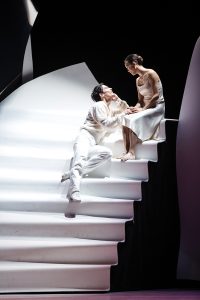Pacific Northwest Ballet: Jean-Christophe Maillot / Cendrillon - Vancouver Ballet Society
- Home
- Reviews 2014 - 2019
- Pacific Northwest Ballet: Jean-Christophe Maillot / Cendrillon

Pacific Northwest Ballet
Jean-Christophe Maillot / Cendrillon
by Tessa Perkins Deneault
The Cinderella story remains a common trope in popular culture and art. In 2016, San Francisco Ballet performed Christopher Wheeldon’s version and the National Ballet of Canada performed James Kudelka’s, to name just two notable dance productions. And, in February of this year, Seattle’s Pacific Northwest Ballet presented Jean-Christophe Maillot’s Cendrillon, premiered by his company, Les Ballets de Monte-Carlo, in 1999.
It’s no small feat to take Charles Perrault’s fairy tale, first adapted to ballet more than 200 years ago, and infuse it with a fresh perspective. Nevertheless, that’s what Maillot has done with his stripped-down Cendrillon.
This is the second Maillot work Pacific Northwest Ballet has taken on (they performed his Roméo et Juliette in 2008 and 2016), and the two pieces share similarities: Prokofiev scores, classic love stories and a focus on a deeper human meaning.
At the heart of Cendrillon is a second love story between Cinderella’s father and the wife he’s grieving that brings out themes of memory, mourning and love. We are continually reminded of the mother: in Maillot’s version, Cinderella is rescued not by a fairy godmother, but by her mother reincarnated in fairy form. Guest artist from Les Ballets de Monte-Carlo, April Ball, coated in glitter and wearing a tutu with a very narrow skirt, was a sprightly star of the show, impressing with precise footwork as the fairy and grace as the mother.
As the ballet begins, Cinderella (Noelani Pantastico on opening night) clutches her mother’s dress as if clinging to memories that might slip through her fingers. Giant three-dimensional notebook pages surround her, covered in unintelligible cursive writing, a key part of the muted, minimalist set design by Ernest Pignon-Ernest. Through an upstage flashback, Cinderella’s father (Seth Orza) tenderly dances with her mother, who tragically collapses.
The Stepmother (Lesley Rausch) enters, interrupting the sombre tone and, in her purple corset, uses her sexuality to control Cinderella’s father. He seems torn between supporting his grieving daughter and pleasing his new wife who tries to seduce him at every turn, often impeding his own movement. The Stepsisters (Rachel Foster and Sarah Ricard Orza) are not ugly in appearance, but in spirit. Like the Stepmother, they move forcefully, with a sharp, determined air. These sisters do not bumble around, and they are not a source of humour; their subtly bandaged heads suggest they are in a constant state of recovery from a cosmetic procedure.
The Pleasure Superintendents (Steven Loch and Miles Pertl), new characters introduced by Maillot, provide much humour, feeding off each other’s silliness. At one point, they perform their own version of Cinderella’s story along with four mannequins who kneel in a row and don pink and blue outfits to represent Cinderella’s future babies.
Instead of the conventional elaborate gown and iconic glass shoes, Cinderella goes to the ball dressed in her mother’s simple slip dress, her bare feet golden and sparkling, transformed by magic when the Pleasure Superintendents lift her to dip her feet in a mysterious bowl. Thus her feet, not the glass slipper, become the coveted object of the Prince’s desire.
Cinderella enters the ballroom feet first; Dominique Drillot’s lighting design puts all attention on them. The bright white stairs that serve as a grand entrance look like they are made from a folded piece of paper, matching Pignon-Ernest’s motif of the large 3-D pages that move around the stage, dividing the space and serving as a backdrop for projections. Costume designer Jérôme Kaplan reflects the characters’ personalities well through their outfits: the Stepmother arrives in a purple garment layered over her corset that features a large scorpion-like tail, and the Stepsisters are dressed in garish red, each with a gigantic bustle protruding off one hip.
Cinderella and the Prince (James Moore) dance as if they are the only two guests, waltzing serenely and later sharing a tender pas de deux where he seems to explore her entire body, slowly running his hands along her limbs.
Maillot’s ballet pays little attention to stops and starts in Prokofiev’s music. Each scene seamlessly melds into the next and nothing is included for the sake of spectacle; each sequence is as detailed and succinct as it needs to be to tell the story most efficiently. One element that jarred was the search for Cinderella, with the only stop in the Prince’s quest being an unidentified place with red- and yellow-costumed “exotics.” Some indication of what culture was being referenced would have been better, as opposed to a generic “other.”
Once reunited, Cinderella and the Prince share another pas de deux of light jumps and a slow discovery of their bodies. Pantastico and Moore’s tender partnership displayed a deep understanding of both their characters’ romance and of each other. Holding his wife’s dress, Cinderella’s father echoes the opening scene while, atop the palace stairs, Cinderella, now in a golden gown, shares a long kiss with her Prince as golden glitter rains on them. These final images leave us to reflect on the magic of love and the power of memory.
DI SUMMER 2017

Photo: Angela Sterling
